
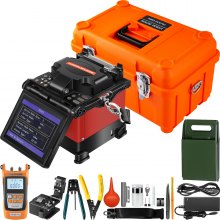












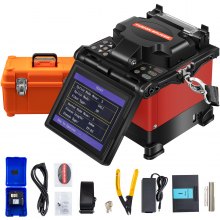












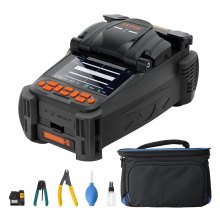












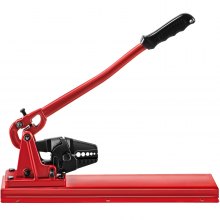











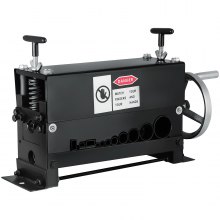











It should come as normal that many of the most conventional vocations, like electrical repair, utilize the potential of smart instruments. From simple necessities to sophisticated, intelligent devices that can improve your overall skills and make your electrical tasks safer and more effective, electrician tools have gone a long way.
Presenting VEVOR Electrician Tools, a state-of-the-art option that will not only make your electrical jobs easier but also prove to be a wise investment for your profession or home renovation projects.
To perform their jobs efficiently and securely, electricians require specialized electrical tools. Therefore, their toolbox should contain various high-tech and heavy-duty, insulated hand tools they may use anywhere their work takes them.
An essential item for any electrician is a pair of pliers. They are typically employed for wire cutting, as well as for grabbing, bending, twisting, and straightening wire. A well-prepared electrician always keeps a variety of pliers in their toolbox or truck, such as side-cutting pliers, long nose pliers, and needle nose pliers for tightening caps, fittings, and locknuts.
To remove and tighten various pieces of hardware, electricians utilize a range of superior insulated screwdrivers or a Phillips screwdriver set, another essential kit item. These days, many experts carry comfortable ratchet screwdrivers with replaceable bits, so they always get caught with the right instrument for electrical work.
To reach wiring and various electrical components, electricians frequently install modern lighting fixtures or must deconstruct hardware that has already been installed. These jobs can be completed more quickly with a portable electric drill equipped with various bits, enabling experts to attach specialized drill bits for use in a particular industry.
Among the many widely used electrician tools is fish tape. Conduit piping is used to carry wire between gang boxes. Fish tape can be supplied via a conduit pipe that has been installed and is kept in place by a retractable coil. The wiring can be connected to the fish tape and retracted, which pulls the wire along the conduit once the tape's end appears on the other side.
Electrical repair and upgrade work is needed in several dark places, such as attics, wall and ceiling cavities, basements, and electrical boxes. Having a tactical flashlight is crucial for both security and ease of use. An indispensable addition to a do-it-yourself electrician's arsenal is a headlamp and a couple of hand flashlights.
All electrical measuring instruments have diverse purposes and are used for determining the electric current's magnitude. This equipment is typically used to measure the following values: power, resistance, voltage, and current.
It is crucial to have precise measurements when slicing and stripping wiring while working with it. Simple retractable tape measures work well for this purpose, but more advanced models with features like multi-step locking and magnetic tips facilitate the operation.
A voltmeter determines the electromotive force of a battery or a voltage difference between two locations in a closed electrical circuit. This instrument needs to have a high electrical resistance to prevent consumption from changing the measurement's accuracy and outcome when connected to the circuit.
An oscilloscope is an electrical tool for measuring electrical signals and displaying them graphically as they change over time. With the aid of this tool, one may visualize fleeting occurrences and more easily diagnose and analyze the functioning of electrical circuits and potential problems.
An ohmmeter is a resistance measurement tool. It assesses the resistance to the electric charge flowing through the circuit when linked in series to the circuit under test. Ohms are commonly used to indicate ohmmeter readings.
An ammeter is a measurement tool used to determine how much current is flowing between any two locations in an electrical circuit. Ampere is the unit of measurement for current, while the meter is the measuring tool.
An electrician power tool is an apparatus that requires an external power source, such as manual labor, to operate. The instruments are employed in many DIY tasks, including building, assembling, packing, and upkeep. They are easy to use and come in various sizes and shapes.
Electricians require a variety of drills, including cordless and corded models, to quickly install and remove electric-powered equipment like outlets and switches. The best cordless one is more convenient and portable, but the first can deliver greater power.
An electric saw can help you cut wires and cables of various diameters more quickly and accurately. You can utilize reciprocating and circular saws, among other varieties, depending on the task. They should each possess particular attributes to enable electricians to do their jobs flawlessly.
In this context, electric screwdrivers play a crucial role. Every time you need to put anything back together, take it apart, or tighten or loosen some hardware, you need a good electric screwdriver that can handle all driving tasks.
They can be corded or cordless, and like the earlier power tools, they have to include rapid charging methods if they are cordless, as well as LED lighting for use in low-light conditions.
There are several strong arguments in favor of choosing to buy VEVOR Electrician Tools. These innovative tools are designed with accuracy, creativity, and dependability in mind, which makes them an invaluable resource for both do-it-yourselfers and electricians.
Their ergonomic designs make extended use more comfortable, which lowers tiredness and increases output. Longevity and reduced replacement costs are also benefits of using VEVOR Electrician Tools, as they are noted for their durability. By selecting VEVOR, you're investing in productivity, safety, and the long-term success of your electrical work.
When handling electricity, electricians need specific safety equipment, including insulated gloves, voltage testers, and arc flash protective gear to keep themselves safe.
Electricians frequently use lineman's pliers for cutting and grasping, wire strippers for effective wire preparation, and needle-nose pliers for precision jobs.
To keep electrician tools in top condition and prepared for effective and safe use, best practices for them include routine cleaning, checks, and storage.